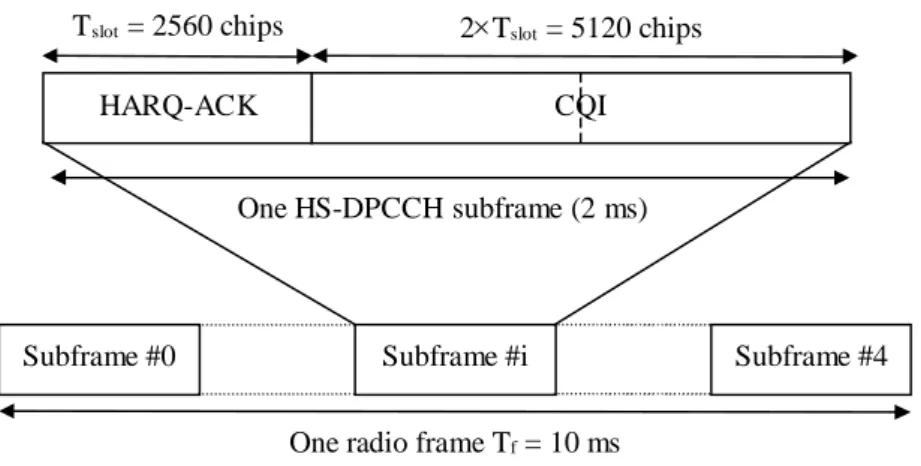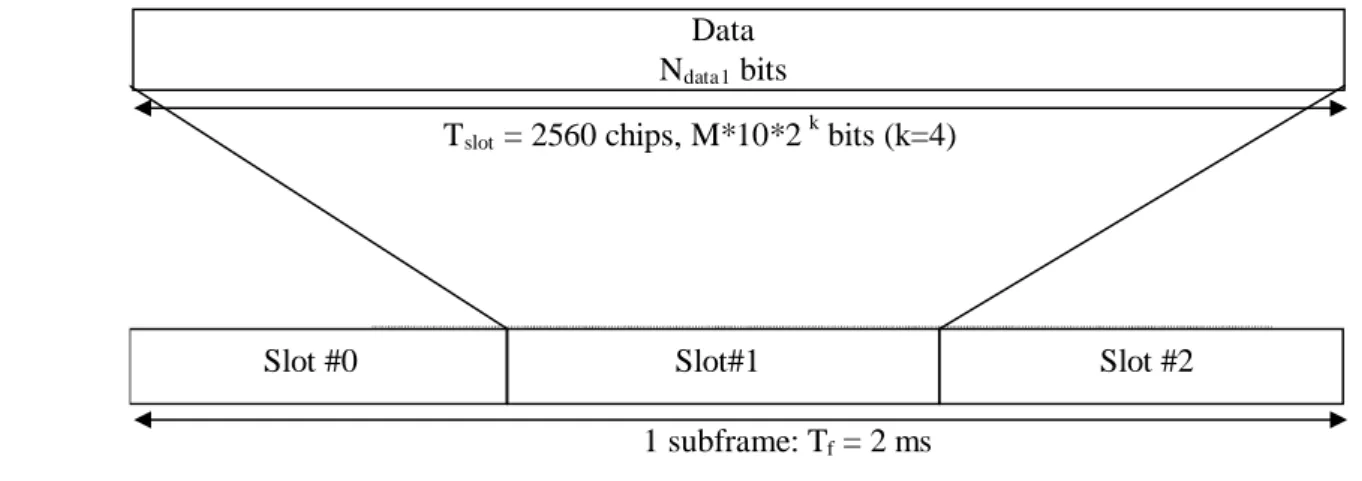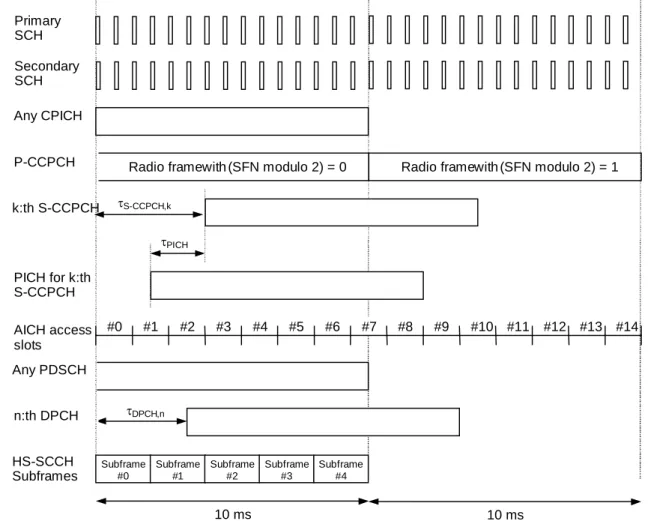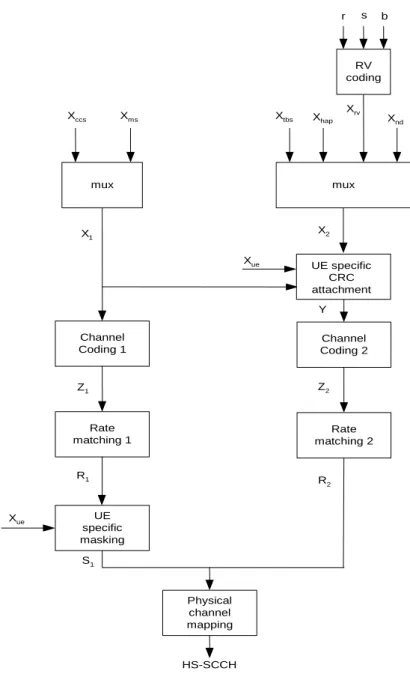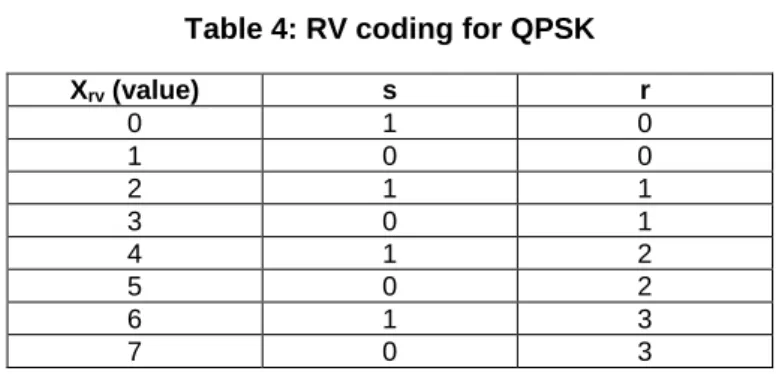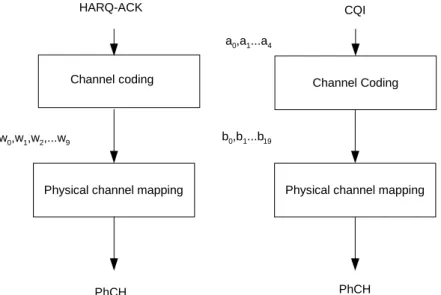HAL Id: hal-01864716
https://hal.archives-ouvertes.fr/hal-01864716
Submitted on 6 Sep 2018
HAL is a multi-disciplinary open access
archive for the deposit and dissemination of
sci-entific research documents, whether they are
pub-lished or not. The documents may come from
teaching and research institutions in France or
abroad, or from public or private research centers.
L’archive ouverte pluridisciplinaire HAL, est
destinée au dépôt et à la diffusion de documents
scientifiques de niveau recherche, publiés ou non,
émanant des établissements d’enseignement et de
recherche français ou étrangers, des laboratoires
publics ou privés.
Mohamed Et Tolba, Mahmoud Ammar, Samir Saoudi
To cite this version:
Mohamed Et Tolba, Mahmoud Ammar, Samir Saoudi. Transmission des canaux de contrôles pour le
HSDPA. [Rapport de recherche] Dépt. Signal et Communications (Institut Mines-Télécom-Télécom
Bretagne-UEB). 2005, pp.11. �hal-01864716�
Transmission des canaux de contrôle pour le
HSDPA
Mohamed ET-TOLBA
Mahmoud AMMAR
Samir SAOUDI
Département Signal et Communications
Ecole Nationale Supérieure des Télécommunications de Bretagne BP 832, 29285 Brest Cedex
Email : mohamed.ettolba@enst-bretagne.fr
Abbreviations
For the purposes of the present document, the following abbreviations apply:
16QAM 16 Quadrature Amplitude Modulation
AICH Acquisition Indicator Channel
CPICH Common Pilot Channel
CQI Channel Quality Indicator
DPCCH Dedicated Physical Control Channel
DPCH Dedicated Physical Channel
HARQ Hybrid-ARQ
HARQ-ACK Hybrid-ARQ Acknowledgement
HS-DPCCH Dedicated Physical Control Channel (uplink) for HS-DSCH
HS-DSCH High Speed Downlink Shared Channel
HS-PDSCH High Speed Physical Downlink Shared Channel
HS-SCCH Shared Control Channel for HS-DSCH
P-CCPCH Primary Common Control Physical Channel
PDSCH Physical Downlink Shared Channel
PICH Page Indicator Channel
PRACH Physical Random Access Channel
S-CCPCH Secondary Common Control Physical Channel
SCH Synchronisation Channel
SF Spreading Factor
SFN System Frame Number
UE User Equipment
UTRAN UMTS Terrestrial Radio Access Network
1
HS-Physical Channels
1.1
Uplink Dedicated Control Channel associated with HS-DSCH
transmission (uplink HS-DPCCH).
Figure 1 illustrates the frame structure of the HS-DPCCH. The HS-DPCCH carries uplink feedback signalling related to downlink HS-DSCH transmission. The HS-DSCH-related feedback signalling consists of Hybrid-ARQ Acknowledgement (HARQ-ACK) and Channel-Quality Indication (CQI) [TS 25.214]. Each sub frame of length 2 ms (3*2560 chips) consists of 3 slots, each of length 2560 chips. The HARQ-ACK is carried in the first slot of the HS-DPCCH sub-frame. The CQI is carried in the second and third slot of a HS-HS-DPCCH sub-frame. There is atmost one HS-DPCCH on each radio link. The HS-DPCCH can only exist together with an uplink DPCCH. The timing of the HS-DPCCH relative to the uplink DPCCH is shown in section 1.4.
Subframe #0 Subframe # i Subframe #4
HARQ-ACK CQI
One radio frame T f = 10 ms
One HS-DPCCH subframe (2 ms) 2 × T slot = 5120 chips
T slot = 2560 chips
Figure 1: Frame structure for uplink HS-DPCCH
The spreading factor of the HS-DPCCH is 256 i.e. there are 10 bits per uplink HS-DPCCH slot. The slot format for uplink HS-DPCCH is defined in Table 1.
Table 1: HS-DPCCH fields
Slot Format #i Channel Bit Rate (kbps) Channel Symbol Rate (ksps) SF Bits/ Subframe Bits/ Slot Transmitted slots per Subframe 0 15 15 256 30 10 3
1.2
Downlink Shared Control Channel (HS-SCCH)
The HS-SCCH is a fixed rate (60 kbps, SF=128) downlink physical channel used to carry downlink signalling related to HS-DSCH transmission. Figure 2 illustrates the sub-frame structure of the HS-SCCH.
Slot #0
Slot#1
Slot #2
T
slot= 2560 chips, 40
bits
Data
N
data1bits
1 subframe: T
f= 2 ms
Figure 2: Subframe structure for the HS-SCCH
1.3
High Speed Physical Downlink Shared Channel (HS-PDSCH)
The High Speed Physical Downlink Shared Channel (HS- PDSCH) is used to carry the High Speed Downlink Shared Channel (HS-DSCH).
A HS-PDSCH corresponds to one channelization code of fixed spreading factor SF=16 from the set of channelization codes reserved for HS-DSCH transmission. Multi-code transmission is allowed, which translates to UE being assigned multiple channelisation codes in the same HS-PDSCH subframe, depending on its UE capability. The subframe and slot structure of HS-PDSCH are shown in figure 3.
Slot #0
Slot#1
Slot #2
T
slot= 2560 chips, M*10*2
kbits (k=4)
Data
N
data1bits
1 subframe: T
f= 2 ms
Figure 3: Subframe structure for the HS-PDSCH
An HS-PDSCH may use QPSK or 16QAM modulation symbols. In figure 3, M is the number of bits per modulation symbols i.e. M=2 for QPSK and M=4 for 16QAM. The slot formats are shown in table 2.
Table 2: HS-DSCH fields Slot format #i Channel
Bit Rate (kbps) Channel Symbol Rate (ksps) SF Bits/ HS-DSCH subframe
Bits/ Slot Ndata
0(QPSK) 480 240 16 960 320 320
1(16QAM) 960 240 16 1920 640 640
All relevant Layer 1 information is transmitted in the associated HS-SCCH i.e. the HS-PDSCH does not carry any Layer 1 information.
1.4
Timing relationship between physical channels
1.4.1
General
The P-CCPCH, on which the cell SFN is transmitted, is used as timing reference for all the physical channels, directly for downlink and indirectly for uplink.
Figure 4 below describes the frame timing of the downlink physical channels. For the AICH the access slot timing is included. Transmission timing for uplink physical channels is given by the received timing of downlink physical channels, as described in the following subclauses.
The following applies:
- SCH (primary and secondary), CPICH (primary and secondary), P-CCPCH, and PDSCH have identical frame timings.
- The S-CCPCH timing may be different for different S-CCPCHs, but the offset from the P-CCPCH frame timing is a multiple of 256 chips, i.e.
τ
S-CCPCH,k = Tk× 256 chip, Tk ∈ {0, 1, …, 149}.- The PICH timing is
τ
PICH = 7680 chips prior to its corresponding S-CCPCH frame timing, i.e. the timing of theS-CCPCH carrying the PCH transport channel with the corresponding paging information, see also subclause 7.2.
- AICH access slots #0 starts the same time as P-CCPCH frames with (SFN modulo 2) = 0. The AICH/PRACH and AICH/PCPCH timing is described in subclauses 7.3 and 7.4 respectively.
- The DPCH timing may be different for different DPCHs, but the offset from the P-CCPCH frame timing is a multiple of 256 chips, i.e.
τ
DPCH,n = Tn× 256 chip, Tn ∈ {0, 1, …, 149}. The DPCH (DPCCH/DPDCH) timingrelation with uplink DPCCH/DPDCHs is described in subclause 7.6.
- The start of HS-SCCH subframe #0 is aligned with the start of the P-CCPCH frames. The relative timing between a HS-PDSCH and the corresponding HS-SCCH is described in subclause 1.4.3.
k:th S-CCPCH AICH access slots Secondary SCH Primary SCH τS-CCPCH,k 10 ms τPICH #0 #1 #2 #3 #4 #5 #6 #7 #8 #9 #10 #11 #12 #13 #14 Radio frame with (SFN modulo 2) = 0 Radio frame with (SFN modulo 2) = 1
τDPCH,n P-CCPCH Any CPICH PICH for k:th S-CCPCH Any PDSCH n:th DPCH 10 ms Subframe #0 HS-SCCH Subframes Subframe #1 Subframe #2 Subframe #3 Subframe #4
Figure 4: Radio frame timing and access slot timing of downlink physical channels
1.4.2
Uplink DPCCH/HS-DPCCH/HS-PDSCH timing at the UE
Figure 5 shows the timing offset between the uplink DPCH, the PDSCH and the DPCCH at the UE. An HS-DPCCH sub-frame starts m×256 chips after the start of an uplink DPCH frame that corresponds to the DL DPCH frame from the HS-DSCH serving cell containing the beginning of the related HS-PDSCH subframe with m calculated as
m = (TTX_diff /256 ) + 101
where TTX_diff is the difference in chips (TTX_diff =0, 256, ..., 38144), between
- the transmit timing of the start of the related HS-PDSCH subframe (see sub-clauses 1.4.3 and 1.4.1) and
- the transmit timing of the start of the downlink DPCH frame from the HS-DSCH serving cell that contains the beginning of the HS-PDSCH subframe (see sub-clause 1.4.1).
At any one time, m therefore takes one of a set of five possible values according to the transmission timing of HS-DSCH sub-frame timings relative to the DPCH frame boundary. The UE and Node Bshall only update the set of values of m in connection to UTRAN reconfiguration of downlink timing.
Uplink DPCH HS-PDSCH at UE Uplink HS-DPCCH 3×Tslot 7680 chips m×256 chips τUEP ≈ 19200 chips Tslot 2560 chips 3×Tslot 7680 chips
Slot #0 Slot #1 Slot #2 Slot #3 Slot #4 Slot #5 Slot #6 Slot #7 Slot #8 Slot #9 Slot #10 Slot #11 Slot #12
Figure 5: Timing structure at the UE for HS-DPCCH control signalling
1.4.3
HS-SCCH/HS-PDSCH timing
Figure 6 shows the relative timing between the HS-SCCH and the associated HS-PDSCH for one HS-DSCH sub-frame. The HS-PDSCH starts τHS-PDSCH = 2×Tslot = 5120 chips after the start of the HS-SCCH.
HS-SCCH HS-PDSCH 3×Tslot 7680 chips τHS-PDSCH (2×Tslot 5120 chips) 3×Tslot 7680 chips HS-DSCH sub-frame
Figure 6: Timing relation between the HS-SCCH and the associated HS-PDSCH.
2
Coding for HS-SCCH
The following information is transmitted by means of the HS-SCCH physical channel. - Channelization-code-set information (7 bits): xccs,1, xccs,2, …, xccs,7 - Modulation scheme information (1 bit): xms,1
- Transport-block size information (6 bits): xtbs,1, xtbs,2, …, xtbs,6 - Hybrid-ARQ process information (3 bits): xhap,1, xhap,2, xhap,3 - Redundancy and constellation version (3 bits): xrv,1, xrv,2, xrv,3
- New data indicator (1 bit): xnd,1
- UE identity (16 bits): xue,1, xue,2, …, xue,16
2.1
Overview
Channel Coding 1 HS-SCCH Physical channel mapping Rate matching 1 mux mux Xccs Xms Xue X1 X2 Xtbs Xhap Xrv Xnd Y Channel Coding 2 Rate matching 2 UE specific masking Z1 Z2 S1 R1 R 2 Xue RV coding r s b UE specific CRC attachment
Figure 7: Coding chain for HS-SCCH
2.2
HS-SCCH information field mapping
2.2.1
Redundancy and constellation version coding
The redundancy version (RV) parameters r, s and constellation version parameter b are coded jointly to produce the value Xrv. Xrv is alternatively represented as the sequence xrv,1, xrv,2, xrv,3 where xrv,1 is the MSB. This is done according
to the following tables according to the modulation mode used:
Table 3: RV coding for 16 QAM
Xrv (value) s r b 0 1 0 0 1 0 0 0 2 1 1 1 3 0 1 1 4 1 0 1 5 1 0 2 6 1 0 3 7 1 1 0
Table 4: RV coding for QPSK Xrv (value) s r 0 1 0 1 0 0 2 1 1 3 0 1 4 1 2 5 0 2 6 1 3 7 0 3
2.3
Multiplexing of HS-SCCH information
The channelization-code-set information xccs,1, xccs,2, …, xccs,7 and modulation-scheme information xms,1 are multiplexed together. This gives a sequence of bits x1,1, x1,2, …, x1,8 where
x1,i = xccs,i i=1,2,…,7
x1,i = xms,i-7 i=8
The transport-block-size information xtbs,1, xtbs,2, …, xtbs,6, Hybrid-ARQ-process information xhap,1,xhap,2, xhap,3, redundancy-version information xrv,1, xrv,2, xrv,3 and new-data indicator xnd,1 are multiplexed together. This gives a sequence of bits x2,1, x2,2, …, x2,13 where
x2,i = xtbs,i i=1,2,…,6
x2,i = xhap,i-6 i=7,8,9
x2,i = xrv,i-9 i=10,11,12
x2,i = xnd,i-12 i=13
2.4
CRC attachment for HS-SCCH
From the sequence of bits x1,1, x1,2, …, x1,8, x2,1, x2,2, …, x2,13 a 16 bits CRC is calculated according to Section 4.2.1.1[TS 25;212]. This gives a sequence of bits c1, c2, …, c16. This sequence of bits is then masked with the UE Identity xue,1, xue,2,
…, xue,16 and then appended to the sequence of bits x2,1, x2,2, …, x2,13 to form the sequence of bits y1, y2, …, y29, where
yi = x2,i i=1,2,…,13
yi = (ci-13 + xue,i-13 ) mod 2 i=14,15,…,29
2.5 Channel coding for HS-SCCH
Rate 1/3 convolutional coding, as described in Section 4.2.3.1 [TS 25.212], is applied to the sequence of bits x1,1,x1,2,
…,x1,8. This gives a sequence of bits z1,1, z1,2, …, z1,48.
Rate 1/3 convolutional coding, as described in Section 4.2.3.1 [TS 25.212], is applied to the sequence of bits y1, y2, …,
y29. This gives a sequence of bits z2,1, z2,2, …, z2,111.
Note that the coded sequence lengths result from the termination of K=9 convolutional coding being fully applied.
2.6 Rate matching for HS-SCCH
From the input sequence z1,1, z1,2, …, z1,48 the bits z1,1, z1,2, z1,4, z1,8, z1,42, z1,45, z1,47, z1,48 are punctured to obtain the output sequence r1,1,r1,2…r1,40.
From the input sequence z2,1, z2,2, …, z2,111 the bits z2,1, z2,2, z2,3, z2,4, z2,5, z2,6, z2,7, z2,8, z2,12, z2,14, z2,15, z2,24, z2,42, z2,48, z2,54,
2.7
UE specific masking for HS-SCCH
The rate matched bits r1,1,r1,2…r1,40 shall be masked in an UE specific way using the UE identity xue,1, xue,2, …, xue,16,to produce the bits s1,1,s1,2…s1,40.
Intermediate code word bits bi, i=1,2…,48, are defined by endcoding the UE identity bits using the rate ½ convolutional
coding described in Section 4.2.3.1 [TS 25.212]. Eight bits out of the resulting 48 convolutionally encoded bits are punctured using the rate matching rule of Section 4.2.7.5 for the HS-SCCH part 1 sequence, that is, the intermediate code word bits b1, b2, b4, b8, b42, b45, b47, b48, arepunctured to obtain the 40 bit UE specific scrambling sequence c1, c2,
….c40. .
The mask output bits s1,1,s1,2…s1,40 are calculated as follows:
s1,k =(r1,k + ck) mod 2 for k = 1,2…40
2.8
Physical channel mapping for HS-SCCH
The HS-SCCH sub-frame is described in section 1.2.
The sequence of bits s1,1, s1,2,, …, s1,40 is mapped to the first slot of the HS-SCCH sub frame. The bits s1,k are mapped to the PhCHs so that the bits for each PhCH are transmitted over the air in ascending order with respect to k.
The sequence of bits r2,1, r2,2,, …,rs2,80 is mapped to the second and third slot of the HS-SCCH sub frame. The bits r2,k are mapped to the PhCHs so that the bits for each PhCH are transmitted over the air in ascending order with respect to k.
3
Coding for HS-DPCCH
Data arrives to the coding unit in form of indicators for measurement indication and HARQ acknowledgement. The following coding/multiplexing steps can be identified:
- channel coding (see subclause 3.1);
- mapping to physical channels (see subclause 3.2).
The general coding flow is shown in the figure below. This is done in parallel for the HARQ-ACK and CQI as the flows are not directly multiplexed but are transmitted at different times.
Physical channel mapping
Channel Coding Channel coding
PhCH b0,b1...b19
Physical channel mapping
HARQ-ACK CQI
a0,a1...a4
PhCH w0,w1,w2,...w9
3.1
Channel coding for HS-DPCCH
Two forms of channel coding are used, one for the channel quality information (CQI) and another for HARQ-ACK (acknowledgement).
3.1.1
Channel coding for HS-DPCCH HARQ-ACK
The HARQ acknowledgement message to be transmitted, as defined in [TS 25.213], shall be coded to 10 bits as shown in Table 5. The output is denoted w0, w1,…w9.
Table 5: Channel coding of HARQ-ACK
HARQ-ACK message to be transmitted w0 w1 w2 w3 w4 w5 w6 w7 w8 w9 ACK 1 1 1 1 1 1 1 1 1 1 NACK 0 0 0 0 0 0 0 0 0 0
3.1.2
Channel coding for HS-DPCCH channel quality information
The channel quality information is coded using a (20,5) code. The code words of the (20,5) code are a linear combination of the 5 basis sequences denoted Mi,n defined in the table below.
Table 6: Basis sequences for (20,5) code
i Mi,0 Mi,1 Mi,2 Mi,3 Mi,4
0 1 0 0 0 1 1 0 1 0 0 1 2 1 1 0 0 1 3 0 0 1 0 1 4 1 0 1 0 1 5 0 1 1 0 1 6 1 1 1 0 1 7 0 0 0 1 1 8 1 0 0 1 1 9 0 1 0 1 1 10 1 1 0 1 1 11 0 0 1 1 1 12 1 0 1 1 1 13 0 1 1 1 1 14 1 1 1 1 1 15 0 0 0 0 1 16 0 0 0 0 1 17 0 0 0 0 1 18 0 0 0 0 1 19 0 0 0 0 1
The CQI values 0 .. 30 as defined in [TS 25.213] are converted from decimal to binary to map them to the channel quality information bits (1 0 0 0 0) to (1 1 1 1 1) respectively. The information bit pattern (0 0 0 0 0) shall not be used in this release. The channel quality information bits are a0 , a1 , a2 , a3 , a4 (where a0 is LSB and a4 is MSB). The output
code word bits bi are given by:
2
mod
)
(
, 4 0a
M
b
in n n i=
∑
×
= where i = 0, …, 19.3.2
Physical channel mapping for HS-DPCCH
The HS-DPCCH physical channel mapping function shall map the input bits wk directly to physical channel so that bits
are transmitted over the air in ascending order with respect to k.
The HS-DPCCH physical channel mapping function shall map the input bits bk directly to physical channel so that bits
